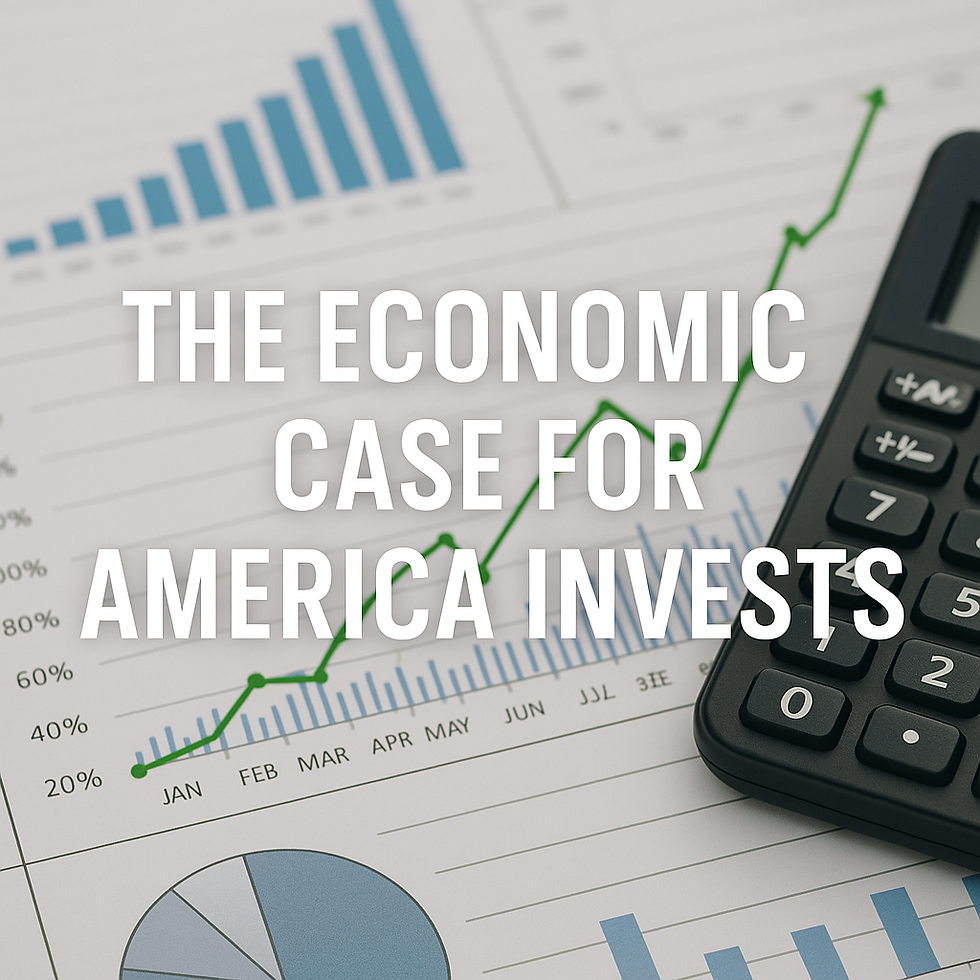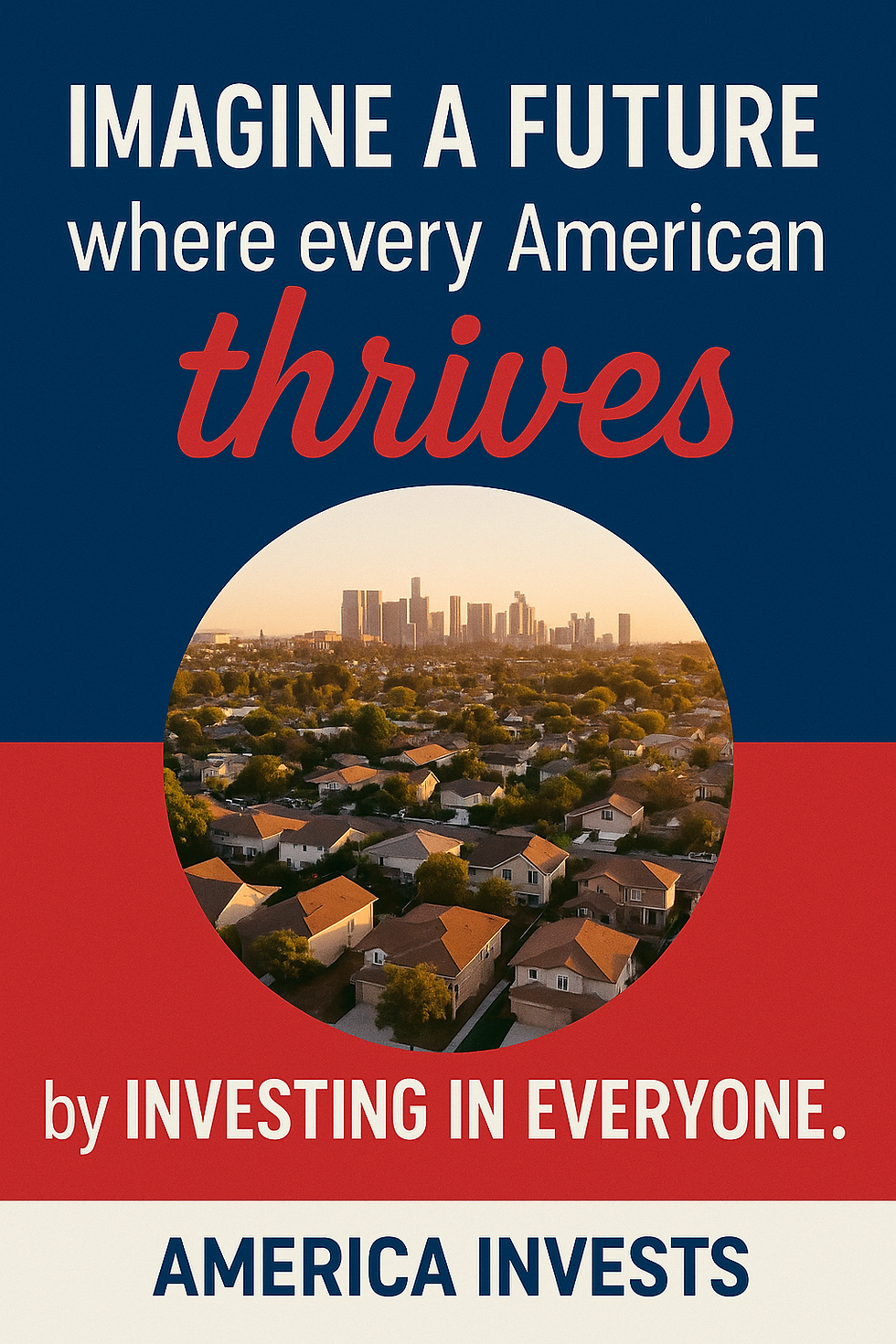The Economic Case for America Invests: Why It Works at Scale
- Daniel Rowe

- Jun 19
- 4 min read

Universal income proposals often attract enthusiasm at the grassroots level—and skepticism at the institutional level. The objections are familiar: How do we fund it? Won’t it slow productivity? Doesn’t it increase inflation?
America Invests was designed to meet those questions head-on. Not with platitudes, but with performance benchmarks, institutional precedent, and real fiscal math.
At its core, this proposal introduces a national investment portfolio that grows over time and returns a dividend to every American citizen. Its purpose is not to replace work, but to stabilize income in a post-labor economy—where job markets alone can no longer serve as the primary mechanism of economic inclusion.
The model is not ideological. It’s structural. And the numbers work.
Benchmarking the Model: Alaska, Norway, and Sovereign Investment Logic
We already have a precedent for this. Alaska’s Permanent Fund Dividend (PFD) has distributed an annual per-resident payout since 1982, funded by oil revenue invested through a sovereign wealth vehicle. The fund reached $76.3 billion in assets in 2023 and has consistently returned between $1,000 and $2,000 per year to each resident—even during periods of economic strain.
Norway’s Government Pension Fund Global, seeded with oil profits in the 1990s, now manages over $1.5 trillion in assets and owns approximately 1.5% of all publicly traded stocks worldwide. It funds public services, absorbs fiscal shocks, and sustains payouts through a regulated withdrawal rule (3% of total assets per year). It does all this while earning long-term returns of 6–7% annually.
America Invests takes the same principle and expands its funding base—from oil royalties to automation fees, tax enforcement gains, and targeted surcharges on extractive practices like excessive stock buybacks and rentier income. It’s a diversification of funding sources built on a proven capital strategy.
Scaling the Fund: From Seed to Self-Sustaining
In its first phase, America Invests can be seeded with transitional revenue:
Annual federal stock buyback tax revenue (projected at $140B+ by 2032 under proposed tax adjustments)
Enhanced IRS enforcement (estimated to recapture $160B/year in evaded taxes with current staffing increases)
Modest automation impact surcharges (modeled at $0.03 per dollar of labor replaced, generating ~$30B/year by 2035)
Even under conservative assumptions (4.5% annual net return), an initial public portfolio reaching $1 trillion in capital would support annual payouts of ~$45 billion. That’s equivalent to a $135/month dividend for every American adult.
As the portfolio compounds and scales—particularly with reinvested deferred dividends and supplemental allocations—annual disbursements can increase to $200, $400, and eventually $800/month within 20 years, without touching the principal or requiring perpetual public appropriation.
Stabilization vs. Redistribution
The dividend is flat and universal. It is not indexed to income, does not phase out with wealth, and requires no means testing. This makes it predictable, efficient, and non-distortive—a stark contrast to many welfare programs that penalize earnings or create benefit cliffs.
Importantly, America Invests is not designed to eliminate inequality. It is designed to stabilize the bottom and broaden the base. Economic data consistently shows that cash transfers to low- and middle-income households result in higher marginal spending, more local economic activity, and reduced public health and safety costs. These are fiscal returns, not just moral ones.
The national GDP impact of a $500/month floor, according to simulations based on marginal propensity to consume (MPC ~0.75 in bottom 60% of income distribution), would result in annual consumption gains of 2.1%—roughly equivalent to the GDP impact of the 2021 American Rescue Plan.
Inflation and Labor Concerns
Critics often argue that broad cash distributions will drive inflation. This risk is significantly mitigated under a fund-based dividend. Unlike stimulus payments funded by deficit spending, the America Invests dividend is tied to real investment returns, not new money creation. It functions similarly to pension disbursements or private portfolio withdrawals.
As for labor market effects, Alaska’s own studies over three decades have shown no measurable decline in employment following annual dividend payments. A 2022 paper by Jones & Marinescu found that the PFD had zero net impact on overall employment—and increased part-time job uptake, particularly in caregiving and service sectors.
In short: people still work. But they work smarter, with more autonomy and less desperation. That’s not a drag on the economy. That’s a correction.
What This Changes Long-Term
The real benefit of America Invests is not the immediate cash injection. It’s what that injection enables:
Improved business formation rates as income volatility drops
Reduced long-term reliance on social insurance programs
Resilience during downturns, as dividends provide countercyclical stability
Reduced youth poverty and educational dropout rates, especially among first-generation students with accumulated childhood dividends
Higher national savings and investment rates, as deferred dividends accrue tax-free growth until withdrawal
This is not a temporary rescue. It’s structural reinforcement.
Final Thought: Policy that Doesn’t Erode
Too many programs collapse when politics shift. America Invests is designed to persist—not because it’s untouchable, but because it’s self-funding, broadly beneficial, and technically insulated.
If we believe in stability, this is what it looks like. If we believe in scale, this is how we reach it. And if we believe that the American economy should benefit everyone—not just those at the top—then this is one of the most fiscally sound ways to do it.
It’s not too big to fail. It’s just too smart to ignore.




Comments